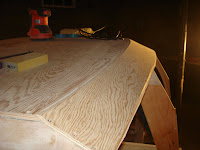Most of yesterday was spent working on Whitecap and getting her ready for launch on June 21st. The weekend schedule is such that launch date is earlier than it would seem and opportunities to spruce her up are few and far between. We got one coat of finish on all the bright work and the all important swim platform. This year the bottom only needs some touch up and we have one side done on that job. Just one more coat of finish on the bright work and the rest of the bottom paint, some serious clean up and she'll be ready to go.
Today was pram day. I had made some templates (again with the help of an old Susan Collins poster) for the bow and stern quarter knees during the past week by taking the measurements off the plans and getting the angles off the boat. We settled on a shape we liked and cut them out. Since the quarter knees were going to be made of mahogany, John wisely thought we should cut a trial model out of a piece of junk wood just to make sure we had all the angles right. That was good because we didn't.

We messed around with it for a while and finally got something that worked for the stern. Next we cut the stern knees out of the mahogany. The bow knees are larger and the angles a little different but we managed to get something that worked there too. After John cut the angles on the straight cuts with the table saw, I cut the curves out with the jig saw and then sanded the corners nice and smooth. Below you see the finished product. This week, I will put a couple barrier coats of epoxy on the knees and they will be ready for installation next weekend. I also hope to get two barrier coats of epoxy on the outside of the hull this week.
Today was pram day. I had made some templates (again with the help of an old Susan Collins poster) for the bow and stern quarter knees during the past week by taking the measurements off the plans and getting the angles off the boat. We settled on a shape we liked and cut them out. Since the quarter knees were going to be made of mahogany, John wisely thought we should cut a trial model out of a piece of junk wood just to make sure we had all the angles right. That was good because we didn't.

We messed around with it for a while and finally got something that worked for the stern. Next we cut the stern knees out of the mahogany. The bow knees are larger and the angles a little different but we managed to get something that worked there too. After John cut the angles on the straight cuts with the table saw, I cut the curves out with the jig saw and then sanded the corners nice and smooth. Below you see the finished product. This week, I will put a couple barrier coats of epoxy on the knees and they will be ready for installation next weekend. I also hope to get two barrier coats of epoxy on the outside of the hull this week.



















